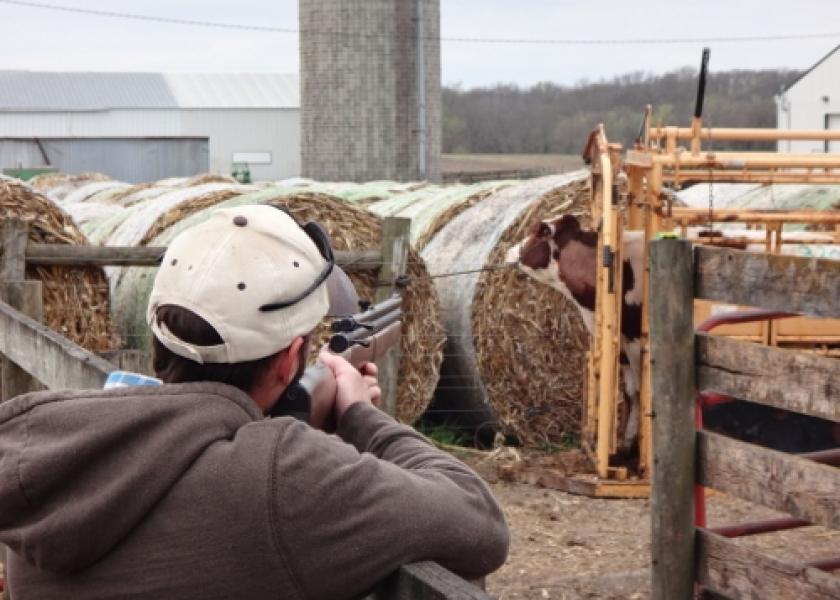Dart Decisions

John Maday
Bring up the topic of medicated darts among a group of cattle producers and veterinarians and you’ll hear a range of strong opinions.
Opponents maintain that darts, or “remote delivery devices” (RDD) as manufacturers call them, should rarely, if ever, be used to treat cattle with antibiotics. They cite potential problems including hitting an inappropriate injection site, injecting the wrong tissue such as into a muscle or vein instead of subcutaneous, inconsistent dosage that could contribute to antibiotic resistance, safety and other concerns.
Proponents stress that RDD can offer convenience and protect animal welfare, allowing treatment in remote pastures where capturing, restraining and/or transporting an animal for hand injection can create additional stress.
Over the past few years, much of the argument on either side has drawn primarily on anecdotal evidence, as research data remains scarce. three recent reports add to the knowledge base, but with somewhat conflicting results, will not definitively end the debate.
Results of one recent study, led by Dr. David Bechtol and the Agri Research Center, Canyon, Texas, indicate producers can, with the appropriate equipment, consistently deliver subcutaneous injections with RDD with results similar to hand injections.
For this test, the researchers used saline injections with food-grade blue dye for visual documentation of distribution of the injected solution. All injections were in the BQA-approved injection sites in the neck. The team used 48 Angus-cross feedyard steers, with each receiving two different subcutaneous injection treatments to either side of the neck. The researchers compared injections using:
- An industry-standard ½-inch 16-gauge needle for hand injection.
- An RDD equipped with a ½-inch 14-gauge needle.
- An RDD equipped with a ¾-inch tri-port 14-gauge needle.
Of the total 68 RDDs delivered, 68 detonated, while two partially deployed with one more so than the other.
According to the research report, the study met its objective of evaluating an RDD equipped with ½-inch 14-gauge versus a ¾-inch 14-gauge tri-port needle in comparison to a hand syringe injection equipped with a standard ½-inch 16-gauge needle. The gross and histopathology results showed an RDD equipped with a ½-inch needle having good skin penetration thus providing subcutaneous injection with no muscle damage, whereas the ¾-inch tri-port needle had good skin penetration with majority subcutaneous injection, but with some minimal muscle penetration. The researchers conclude that the RDD equipped with a ½-inch 14-gauge needle is adequate for subcutaneous injections with least amount of muscle penetration and equal to that of a hand syringe injection.
In contrast, a study from Kansas State University’s Beef Cattle Institute led by Dr. Hans Coetzee, found inconsistencies. In this study, researchers used RDD to inject cattle with Draxxin (tulathroymycin). Of 15 animals treated using RDD, four of the darts failed to deliver the drug. In other cases, researchers found trace amounts of the drug in the animals, but not at efficacious levels. They also found that darted animals had a lower overall exposure to Draxxin compared to animals that treated with a conventional injection.
The researchers also point out that the test animals were restrained with rope halters, with an experienced veterinarian firing the darts from a dead rest at a fixed distance. And yet, in one-third of the treated animals, the dart hit outside the Beef Quality Assurance (BQA)-compliant injection-site area of the neck.
Mississippi State University researchers recently conducted a similar trial, and MSU veterinarian Amelia Woolums, DVM, PhD, presented preliminary findings during the summer Academy of Veterinary Consultants Conference. The trial examined pharmacokinetics of tulathromycin with RDD delivery.
In this small trial, researchers compared three delivery routes:
- Air-powered RDD rifle with ¾-inch 14-gauge needles, fired from a distance of 25 feet.
- CO2-powered RDD rifle with ¾-inch 14-gauge needles, fired from a distance of 35 feet.
- Conventional subcutaneous injection with ¾-inch 16-guage needles.
The animals were restrained and shot placement in every case was within the recommended injection-site triangle on the neck.
In this test, three of 15 air-fired darts failed to discharge. The darts fired and penetrated the animal’s skin, but did not inject the dose.
All the other darts, including all those from the CO2-powered rifle, deployed properly, and subsequent blood testing indicated drug distribution from the darts was similar to that from the conventional subcutaneous injection. More detailed pharmacokinetics results will be reported later.
Woolums notes that the three treatment failures would be significant in a commercial setting. The researchers weighed each dart after it dropped off the target animal and used those weights to determine whether the darts discharged the full dose of antibiotic. Producers using RDD in the field would be unlikely to take that step or be able to determine which animals did not receive a proper dose.
In this trial, researchers did not use cartridge-powered or powder-charged RDD rifles, which use various .22-caliber blank cartridges to propel the dart. During the Q&A session, one veterinarian stressed the need to use appropriate cartridges, intended for RDD. Some users, he said, have purchased hardware-store nail-gun charges that are too powerful for RDD use. They will cause the dart to penetrate too deeply, resulting in improper injections and possible injury to the animal.
More research is needed, but in the meantime, veterinarians and producers should limit their use of RDD treatments to necessity, rather than convenience. If you have instances where RDD seems the best choice, take reasonable steps to ensure compliance with BQA guidelines. Comply fully with product labels, including mode of injection, total dosage and maximum dosage per injection site. Keep detailed records of all treatments, recover used darts when possible for safety and to verify the dose was injected, and follow all gun-safety rules.







